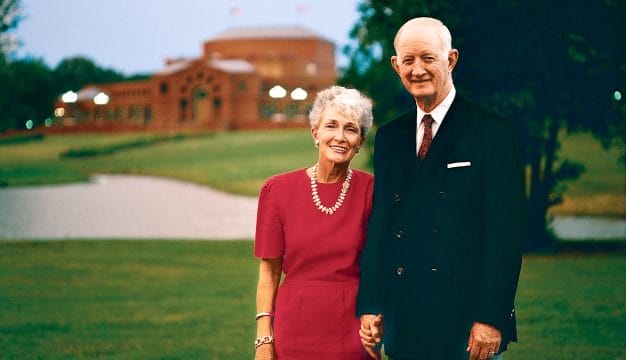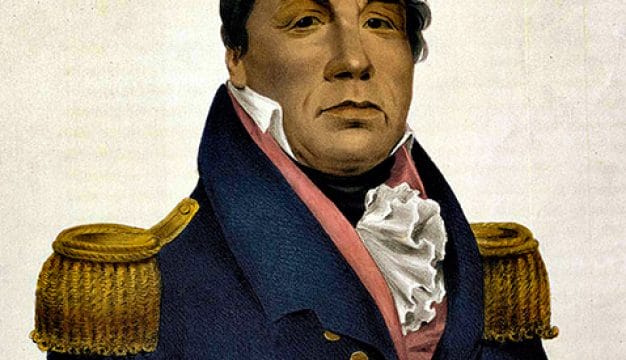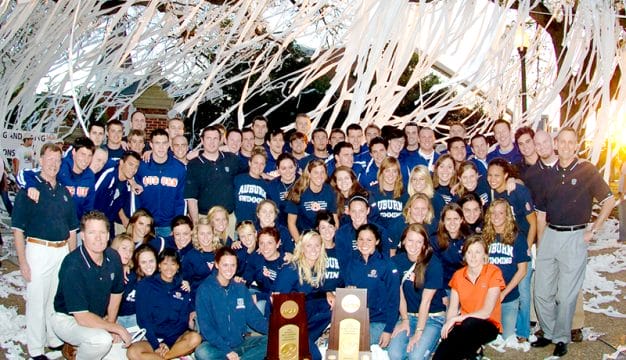Richmond Pearson Hobson
Greensboro, Hale County,
 Richmond Pearson Hobson
native Richmond Pearson Hobson (1870-1937) was a graduate of the United States Naval Academy and served in the Spanish-American War. He became famous for sinking the collier USS Merrimac in Cuba’s Santiago Harbor, for which he was awarded the Congressional Medal of Honor. A champion of U.S. naval supremacy, Hobson also supported the Progressive Era ideals of prohibition, improved education, and women’s suffrage as a Democratic congressional representative from Alabama’s Sixth District.
Richmond Pearson Hobson
native Richmond Pearson Hobson (1870-1937) was a graduate of the United States Naval Academy and served in the Spanish-American War. He became famous for sinking the collier USS Merrimac in Cuba’s Santiago Harbor, for which he was awarded the Congressional Medal of Honor. A champion of U.S. naval supremacy, Hobson also supported the Progressive Era ideals of prohibition, improved education, and women’s suffrage as a Democratic congressional representative from Alabama’s Sixth District.
Hobson was born to James Hobson, a probate judge, and Sarah Pearson Hobson on August 17, 1870, at the family plantation, Magnolia Grove, in Greensboro, Hale County. One of seven children, he was initially tutored at home and then enrolled in Greensboro’s Southern University (now Birmingham-Southern College) at the age of 12. After graduation in 1885, he won an appointment to the United States Naval Academy and at the age of 15 was the youngest midshipman in his class. He distinguished himself as a skilled orator and student and graduated first in his class of 1889.
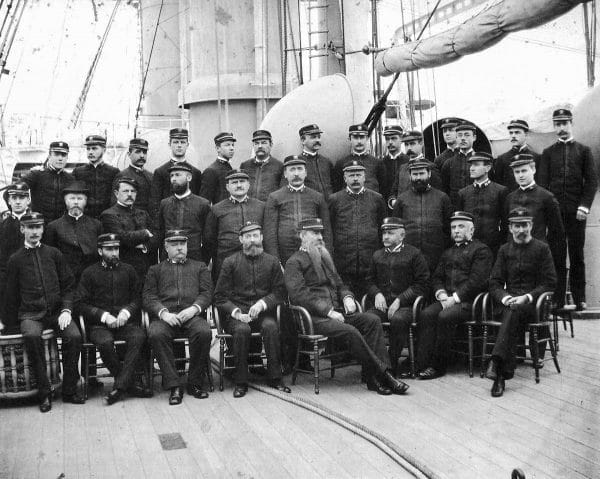 Officers of the USS Chicago
After graduation, Hobson served a two-year assignment as the assistant navigator aboard the cruiser USS Chicago. Thereafter, he spent four years continuing his naval education in Paris, France, at a French school of naval design. In 1893, Hobson was appointed Assistant Naval Constructor at the U.S. Navy’s Bureau of Construction and Repair in Washington, D.C. In this capacity, he supervised the construction of new naval vessels across the nation; he would later advocate for the removal of all woodwork on ships because it was such a fire hazard. Eager to promote a professional military education for young naval officers, he established a three-year postgraduate course at the Naval Academy for officers in the Construction Corps.
Officers of the USS Chicago
After graduation, Hobson served a two-year assignment as the assistant navigator aboard the cruiser USS Chicago. Thereafter, he spent four years continuing his naval education in Paris, France, at a French school of naval design. In 1893, Hobson was appointed Assistant Naval Constructor at the U.S. Navy’s Bureau of Construction and Repair in Washington, D.C. In this capacity, he supervised the construction of new naval vessels across the nation; he would later advocate for the removal of all woodwork on ships because it was such a fire hazard. Eager to promote a professional military education for young naval officers, he established a three-year postgraduate course at the Naval Academy for officers in the Construction Corps.
As a naval officer and later a congressman, Hobson consistently championed America’s need to achieve naval supremacy to protect America’s physical security and to safeguard the nation’s economic interests, particularly in Asia and South America. Moreover, Hobson maintained that a strong navy would provide America with the power and influence to maintain world peace. In championing the nation’s naval supremacy, Hobson echoed views similar to the better known Alfred Thayer Mahan, the nation’s leading naval strategist. Both Hobson and Mahan maintained that a strong naval presence would allow America to project greater influence throughout the world.
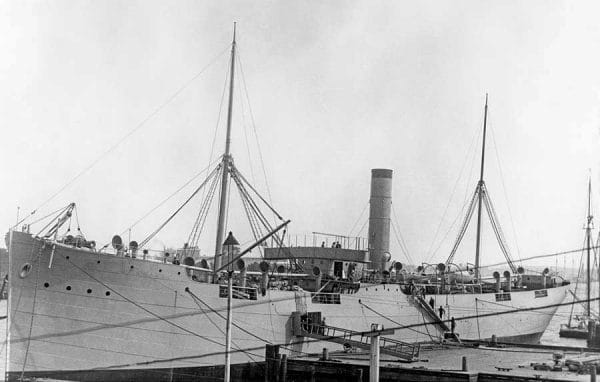 USS Merrimac
When war was declared with Spain in April 1898, Hobson was serving as a lieutenant aboard the USS New York, the flagship of the North Atlantic Squadron, under the command of Admiral William T. Sampson. The United States had long been interested in the affairs of Cuba, which was in the midst of a struggle for independence from Spain that many in the United States supported. The U.S. Navy implemented a blockade of Cuba in an attempt to assist the insurgency. Spanish admiral Pasqual Cervera’s Caribbean Squadron, however, penetrated the American blockade and anchored in Santiago Harbor. In order to remove the threat posed by the Spanish vessels, Sampson and Hobson devised a plan to block the entrance to the harbor. On the morning of June 3, Hobson and his crew of seven attempted to sink the USS Merrimac in the entrance of the harbor to create an obstruction that would trap the Spanish ships. When Hobson guided the Merrimac into the narrow part of the harbor’s entrance, it quickly came under fire from the Spanish fleet that disabled its steering. As the ship drifted out of Hobson’s control, he tried to sink it by exploding the vessel’s five torpedoes but succeeded in detonating only two. When the Merrimac finally sank, it had moved beyond the entrance to the harbor, leaving the channel open. The Spanish captured Hobson and his crew and held them as prisoners of war until July 6. Though Hobson and his crew failed to blockade the Santiago Harbor (the Spanish force would be soundly defeated while fleeing the harbor on July 3), they received a heroes’ welcome for their courageous exploits upon their return to the United States. For two years after the Spanish-American War, Hobson salvaged sunken Spanish ships in Santiago Harbor and in Manila Bay in the Philippines, where he contracted a debilitating case of typhoid fever. In January 1903, Hobson resigned from the U.S. Navy after 18 years of active service. Now a civilian, Hobson embarked on a nationwide lecture tour, championing U.S. naval supremacy and a progressive agenda.
USS Merrimac
When war was declared with Spain in April 1898, Hobson was serving as a lieutenant aboard the USS New York, the flagship of the North Atlantic Squadron, under the command of Admiral William T. Sampson. The United States had long been interested in the affairs of Cuba, which was in the midst of a struggle for independence from Spain that many in the United States supported. The U.S. Navy implemented a blockade of Cuba in an attempt to assist the insurgency. Spanish admiral Pasqual Cervera’s Caribbean Squadron, however, penetrated the American blockade and anchored in Santiago Harbor. In order to remove the threat posed by the Spanish vessels, Sampson and Hobson devised a plan to block the entrance to the harbor. On the morning of June 3, Hobson and his crew of seven attempted to sink the USS Merrimac in the entrance of the harbor to create an obstruction that would trap the Spanish ships. When Hobson guided the Merrimac into the narrow part of the harbor’s entrance, it quickly came under fire from the Spanish fleet that disabled its steering. As the ship drifted out of Hobson’s control, he tried to sink it by exploding the vessel’s five torpedoes but succeeded in detonating only two. When the Merrimac finally sank, it had moved beyond the entrance to the harbor, leaving the channel open. The Spanish captured Hobson and his crew and held them as prisoners of war until July 6. Though Hobson and his crew failed to blockade the Santiago Harbor (the Spanish force would be soundly defeated while fleeing the harbor on July 3), they received a heroes’ welcome for their courageous exploits upon their return to the United States. For two years after the Spanish-American War, Hobson salvaged sunken Spanish ships in Santiago Harbor and in Manila Bay in the Philippines, where he contracted a debilitating case of typhoid fever. In January 1903, Hobson resigned from the U.S. Navy after 18 years of active service. Now a civilian, Hobson embarked on a nationwide lecture tour, championing U.S. naval supremacy and a progressive agenda.
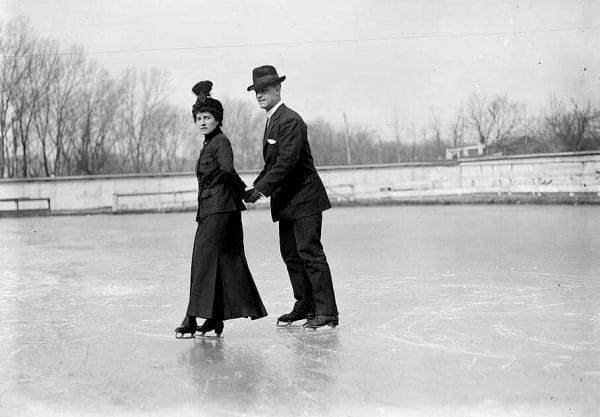 Rep. Richmond and Grizelda Hobson
On May 25, 1905, Hobson married Kentucky native Grizelda Houston Hull in Tuxedo Park, N.Y., with Hobson’s close friend inventor Nicola Tesla serving as a groomsman. The couple would have three children. In 1906, Hobson was elected a U.S. congressman from Alabama’s Sixth District and would serve four terms between 1907 and 1915. Ideologically a progressive, he promoted the building of roads and schools in rural areas and expanding agricultural instruction in rural areas and government regulation of railroads. Hobson supported a graduated income tax and the direct election of senators, which eventually became the 16th and 17th Amendments to the U.S. Constitution, respectively. He also shepherded through Congress a bill that led to the establishment of the Office of the Chief of Naval Operations. This office assumed responsibilities for commanding and overseeing the Navy’s resources and personnel. The Chief of Naval Operations served as the senior military officer in the Navy and also served as an advisor to the Secretary of the Navy. Hobson also took a progressive stance on women’s suffrage, viewing it as a fundamental element in the evolution of humankind and arguing that allowing women to vote would broaden their views and thus make them well-informed citizens.
Rep. Richmond and Grizelda Hobson
On May 25, 1905, Hobson married Kentucky native Grizelda Houston Hull in Tuxedo Park, N.Y., with Hobson’s close friend inventor Nicola Tesla serving as a groomsman. The couple would have three children. In 1906, Hobson was elected a U.S. congressman from Alabama’s Sixth District and would serve four terms between 1907 and 1915. Ideologically a progressive, he promoted the building of roads and schools in rural areas and expanding agricultural instruction in rural areas and government regulation of railroads. Hobson supported a graduated income tax and the direct election of senators, which eventually became the 16th and 17th Amendments to the U.S. Constitution, respectively. He also shepherded through Congress a bill that led to the establishment of the Office of the Chief of Naval Operations. This office assumed responsibilities for commanding and overseeing the Navy’s resources and personnel. The Chief of Naval Operations served as the senior military officer in the Navy and also served as an advisor to the Secretary of the Navy. Hobson also took a progressive stance on women’s suffrage, viewing it as a fundamental element in the evolution of humankind and arguing that allowing women to vote would broaden their views and thus make them well-informed citizens.
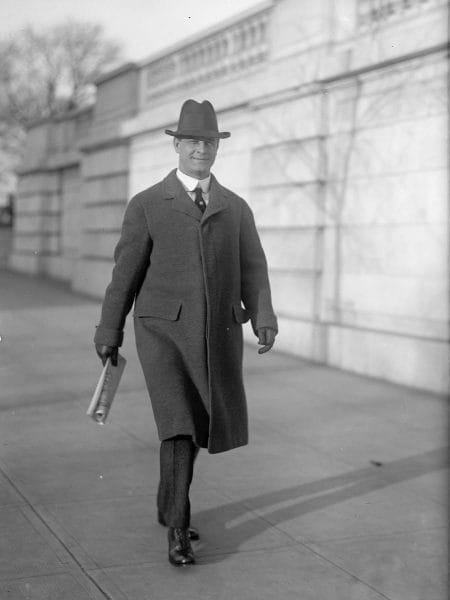 Rep. Richmond P. Hobson, 1914
For nearly three decades, however, Hobson’s most consuming cause became banning alcohol and narcotics. He approached prohibition as a moral crusade, believing that alcohol consumption impeded the proper, progressive course of human development and evolution by weakening intellectual capabilities. In 1908, he campaigned for a prohibition amendment in Alabama, which once passed made the state dry before the nation embraced the prohibition of alcohol. In 1919, Hobson authored Alcohol and the Human Race, in which he argued that alcohol was a cause of human degeneracy. After the passage of the 18th Amendment in 1919, Hobson turned his attention to launching a world-wide prohibition campaign and raising awareness on the evils of narcotics, particularly heroin. He helped organize the International Narcotic Education Association (1923) and the World Narcotic Defense Association (1927). Although his anti-narcotics campaign never gained the momentum that the American prohibition campaign had, Hobson presided at a meeting in Geneva, Switzerland, in 1931 at which 57 countries agreed to limit the production of opium.
Rep. Richmond P. Hobson, 1914
For nearly three decades, however, Hobson’s most consuming cause became banning alcohol and narcotics. He approached prohibition as a moral crusade, believing that alcohol consumption impeded the proper, progressive course of human development and evolution by weakening intellectual capabilities. In 1908, he campaigned for a prohibition amendment in Alabama, which once passed made the state dry before the nation embraced the prohibition of alcohol. In 1919, Hobson authored Alcohol and the Human Race, in which he argued that alcohol was a cause of human degeneracy. After the passage of the 18th Amendment in 1919, Hobson turned his attention to launching a world-wide prohibition campaign and raising awareness on the evils of narcotics, particularly heroin. He helped organize the International Narcotic Education Association (1923) and the World Narcotic Defense Association (1927). Although his anti-narcotics campaign never gained the momentum that the American prohibition campaign had, Hobson presided at a meeting in Geneva, Switzerland, in 1931 at which 57 countries agreed to limit the production of opium.
On April 29, 1933, nearly 35 years after the Merrimac exploit, President Franklin D. Roosevelt awarded Hobson and his crew the Congressional Medal of Honor for their heroism. By a special act of Congress, and long after his retirement, Hobson was promoted to Rear Admiral in June 1934, based upon the physical stresses he suffered while in the service and his congressional work on behalf of the Navy. Three years later, on May 17, 1937, Hobson died at his home in New York City. Though his memoirs and other histories are unclear as to why Hobson moved to New York, that was his wife’s birthplace and the location of anti-narcotics and prohibition organizations.
 Magnolia Grove
He is buried in Arlington National Cemetery. In honor of Hobson’s naval service, the Navy christened a destroyer the USS Hobson (DD-464) at the Charleston Navy Yard in South Carolina in September 1941. Thereafter, Alabamians began to commemorate their native son. In May 1942, a bronze bust of Hobson was unveiled at the state capitol in Montgomery. The following year, Magnolia Grove, his birthplace, was deeded to the state and dedicated as a state shrine. Two Alabama cities are named for Richmond Hobson: Hobson City, Calhoun County, and Hobson, Washington County.
Magnolia Grove
He is buried in Arlington National Cemetery. In honor of Hobson’s naval service, the Navy christened a destroyer the USS Hobson (DD-464) at the Charleston Navy Yard in South Carolina in September 1941. Thereafter, Alabamians began to commemorate their native son. In May 1942, a bronze bust of Hobson was unveiled at the state capitol in Montgomery. The following year, Magnolia Grove, his birthplace, was deeded to the state and dedicated as a state shrine. Two Alabama cities are named for Richmond Hobson: Hobson City, Calhoun County, and Hobson, Washington County.
Further Reading
- Hobson, Richmond Pearson. Alcohol and the Human Race. New York: Fleming R. Revell Co., 1919.
- ———. The Sinking of the Merrimac: A Personal Narrative of the Adventure in the Harbor of Santiago de Cuba, June 3, 1898, And of the Subsequent Imprisonment of the Survivors. New York: Century Co., 1899.
- Pittman, Walter E. Navalist and Progressive: The Life of Richmond P. Hobson. Manhattan, Kan.: MA/AH Publishing, 1981.
- Rosenfeld, Harvey. Richmond Pearson Hobson: Naval Hero from Magnolia Grove. Las Cruces, N.M.: Yucca Free Press, 2000.
